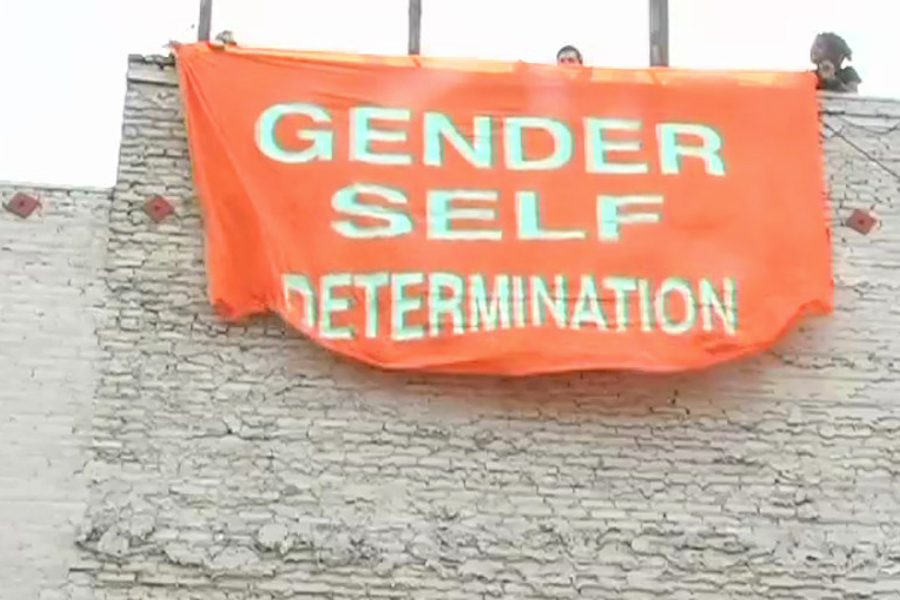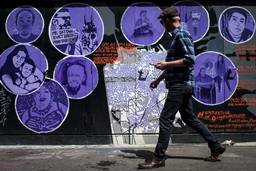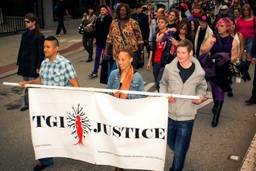The Filmmakers Behind ‘Criminal Queers’ Explain Why “Queer Liberation is Prison Abolition”
Toshio Meronek

When queer and transgender people fought back against police brutality during the riots at Stonewall Inn in New York City and Compton’s Cafeteria in San Francisco back in the 1960s, it was a time when you could go to jail for how you dressed or who you had sex with. The Supreme Court recently ruled in favor of marriage equality for LGBT people. But how much has actually changed?
The LGBT progress narrative promoted by the mainstream media applies mainly to the whitest and most affluent among us. With the rise of mass incarceration, today the problem of queer criminalization is arguably worse. Queer and trans people of color and those from low-income backgrounds suffer the most — and are imprisoned in higher numbers than in those early days of the gay liberation movement. (Black trans women are the most targeted: one in every five black trans women has spent time behind bars.)
One coping mechanism for queer and trans people dealing with the harsh realities of criminalization and violence: “camp” that makes light of the system keeping them down.
Made over eight years for a few thousand dollars, Eric A. Stanley and Chris Vargas’s film Criminal Queers does exactly that — deftly mocking the prison industrial complex with a fictional gang of queer conspirers that includes the real Angela Davis, as well as Stonewall veteran Miss Major and millennial abolitionist icon CeCe McDonald. (The latter two will soon be the subjects of their own bio-documentaries currently in production, MAJOR and Free CeCe.)
Criminal Queers is a sequel to Homotopia, another film that critiques assimilation and gay marriage, presenting an intervention against the mainstream LGBT movement’s respectability politics. This time around, the critique is dressed up as a prison break comedy with an aesthetic style that is undeniably born out of the contemporary Bay Area queer activist art scene.
Criminal Queers premiered in June at Outside the Frame: Queers for Palestine Film Festival in San Francisco. Below, the filmmakers explain how, as a scene from the movie declares, “Queer Liberation is Prison Abolition.”
Why did you decide to make a movie about prison abolition from the point of view of queer and trans people?
Eric A. Stanley: The violent logics of the prison industrial complex (PIC) inhabit every corner of trans/queer existence, and yet we find ourselves in a historic moment where many LGBT people and organizations reproduce the same “law and order” politics that have devastated so many lives. We wanted to recall past trans/queer struggles against the PIC so that we might help collectively build alternative futures that did not give epistemic brutality a rainbow makeover and call it progress.
Chris Vargas: Queer and trans liberation is born out of responses to the hyper-policing of our bodies and cultural spaces. Too many people assume that when all gay people benefit from marriage rights then we’ve made it, and of course that’s not true.
The most marginalized among us experience the most violence at the hands of the state in the form of hyper-surveillance and incarceration. We thought this an important issue to address.
The movie suggests that it takes a movement, not a few individuals, to upend the racist, classist, anti-queer and trans prison system. We see literally hundreds of different characters all helping to plot the downfall of the system in this film. Talk about a few notable ones.
EAS: I am really excited that we were able to include living legends like Miss Major, who is a veteran of the Stonewall uprising and executive director of the Transgender, Gender Variant and Intersex Justice Project, who holds it down for formally incarcerated trans women of color. We also wanted to keep things intergenerational, because in trans and queer subcultures cross-generational organizing is fairly uncommon. Because of HIV/AIDS, and other forms of structured abandonment, we have missing generations of trans/queer brilliance, so I think it’s really important that we learn with and from people of different generations.
CV: It’s so hard to pick a favorite. There are so many brilliant people in the movie! Angela Davis, CeCe McDonald, Miss Major – just to name a few. The whole film features a ton of people — longtime friends, strangers, lovers, exes, artists, activists, scholars, all with their own performance style, and it’s so amazing they all appear together in one project.
Any other queer luminaries you wish could’ve made cameos?
Chris: I would have loved to feature Chelsea Manning somehow, but Eric and I never found ourselves in Fort Leavenworth, Kansas where she is being detained. Also, it would’ve been great to include a cameo of Monica Jones, who ignited a national campaign against “walking while trans” and the criminalization of trans sex workers of color.
How does somebody make a feature-length movie with a budget of a few thousand dollars?
CV: Lying, cheating, and stealing, mostly. But seriously: over the years we’ve shown rough cuts of the movie at colleges and universities, and been given screening fees for doing so. We’ve used those funds to pay for the relatively inexpensive props, costumes and food for the cast and crew. We also finally got our first grant just recently, which has helped to pay an editor to do the final edit. Thank you, Trans Justice Funding Project! But mostly, we thrifted all the costumes, never paid to rent a location — we either had it donated or just showed up and shot guerilla-style.
EAS: The idea that a radical project could even be funded is fairly recent. We see Criminal Queers in the long genealogy of scam-artist that have, as Chris said, figured out ways to build the kinds of worlds we want to inhabit, and this includes our aesthetic worlds. Improvisation is both an analytic and a skill that I think is worth collectively growing. By this I mean that while we shouldn’t fetishize the deep lack of resources trans, queer, and gender nonconforming artists have access to, I also don’t want to support the myth that if a project is not financially backed that it cannot be fabulous.
Why did it take eight years to finish this film?
EAS: There are both material and theoretical answers to this question. We did not approach this film project in a traditional way — meaning a tight script or storyboards or any of that. We had some ideas of where we wanted the narrative to go, but during filming something unexpected might happen that would reconfigure the plot structure.
We have sometimes talked about the process as a durational performance where we can return again to the film and re-edit and re-shoot parts, so it is constantly changing and in conversation with our shifting political landscape. We have been screening the film in different versions for the past five or so years, and almost every time it’s a slightly different film.
CV: Also, I’ve suspected all along that, just like one of our favorite movies of all time and a major inspiration for the movie, Born in Flames, that it would also take us 10 years to make this. But in fact, it’s only taken eight. It’s taken so long because we were never that concerned with selling the movie, or submitting it to high-profile, commercially oriented film festivals. We also weren’t beholden to funders so didn’t have to make sure we paid out on anyone’s investment.
We started the project in 2007 at a moment where queer and trans anti-PIC organizing was starting to gain lots of momentum and I think the film does a good job highlighting the movement and all the incredible energy, as well as many people, associated with it.
Why did you decide to premiere this movie at a Palestine solidarity film fest organized by queer activists, rather than a more mainstream film festival?
EAS: We are at this particular moment where people are confusing supporting films with supporting movements. I think films and every kind of art are vital to the work of building mass movements. However, it’s important to ask why a film can raise $100,000 or more through crowdfunding, while at the same time raising money for direct support for people is almost impossible (including the people the film is about). To this end, I’m interested in how Criminal Queers can be of service to our struggles and not simply use them as a way to build an artistic brand.
This is perhaps a long way to say that we see the struggle for Palestinian liberation bound up with prison abolition and trans/queer liberation struggles. This is particularly clear when we understand the occupied territories to be what some have called, referencing Gaza, “the largest open air prison in the world.” This is not to say that these struggles are interchangeable, as they are geopolitically and historically situated. However, these connections and the frictions can help us build transnational solidarities, which is perhaps empire’s worst fear.
ITT: What’s behind the decision to make all your screenings free?
CV: Our rationale behind making screenings of the film free relates to our aversion to crowdfunding. There are better places to take money than from our own community. I understand that the U.S. is terrible when it comes to federal funding for the arts, so people resort to crowdsourcing to make their work. But instead of spending the energy asking $20 from all my friends, I’d rather bark up wealthier trees or do projects cheap or free. This relates to the screenings as well; we’d rather give back to our communities by way of a free screening than make a few bucks off them. Plus, free admission ensures that anyone regardless of income can attend if they want to.
EAS: Under global capitalism, we usually have to choose between bad and worse options. So knowing that there is no way outside systems of accumulation, we still wanted to at least try to disrupt them. For us, that has meant thinking about the production and distribution of our films as part of the political project. Before the total commodification of every marginalized identity by way of the niche film festival circuit, creating alternative screening venues was how we got our work shown.
Are you working on any upcoming film or art projects?
CV: Since 2013, I’ve been working on a project called Museum of Transgender Hirstory & Art (MOTHA), a conceptual museum project that is dedicated to highlighting the cultural work of trans artists, hirstorians and scholars. The project is also ambivalent in regards to the processes of granting institutional legitimacy. MOTHA is an imaginary museum and is forever “under construction,” and it occasionally takes the form of temporary autonomous events, including performances, exhibitions, panel discussions, public programs, and other occasions. Right now I’m working on a series of gallery exhibitions and an eventual catalog entitled “Trans Hirstory in 99 Objects.”
EAS: Although it is not a project I am directly involved with, I’m really excited about is Reina Gossett & Sasha Wortzel’s new film Happy Birthday Marsha. It’s still in pre-production, but it’s using hirstory and narrative cinema to think about Marsha P. Johnson and Sylvia Rivera’s lives as prefiguring the current trans/queer/gender-nonconforming prison abolitionist moment we are in. These are exactly the kinds of films we need.
At some point, I want to work on an experimental documentary about Gay Shame, a radical trans/queer direct action collective I’ve been organizing with for a long time. However, because we are still active, I don’t want the project to turn Gay Shame’s work into a remnant of time. I’ve been thinking a lot about how to make the film a tool rather than a cultural artifact. I’m guessing, like Criminal Queers, it might take a decade or more, but hopefully will be worth it.




